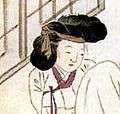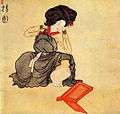Gache
The gache (Korean: 가체; Hanja: 加髢) is a big wig worn by Korean women. Women of high social backgrounds and kisaeng wore them. Like their western contemporaries Koreans considered bigger and heavier wigs to be more aesthetically pleasing.[1] However, there is a record of an incident where a heavy gache wig led to the death of a 13-year-old bride as the heavy wig compromised her neck as she was getting up to greet her father-in-law entering the room. Also due to its costliness, some lower-class families took up to 6–7 years preparing a new gache wig for their new daughter-in-law.[2]
| Gache | |
 | |
| Korean name | |
|---|---|
| Hangul | 가체 |
| Hanja | 加髢 |
| Revised Romanization | gache |
| McCune–Reischauer | kach'e |
The gache also flourished in Goryeo, the Three Kingdoms, Balhae, the Gaya confederacy, and Gojoseon. They were decorated with silk objects, gold, jewels, silver, coral, jade, etc. Certain decorations were reserved for royalty.
Such was the women's frenzy for the gache that in 1788, King Jeongjo of Joseon prohibited and banned by royal decree the use of gache as they were deemed contrary to Confucian values of reserve and restraint.[3] In the 19th century, yangban women began to wear jokduri, a small hat that substituted for the gache. However gache still enjoyed vast popularity in kisaeng circles and traditional weddings. Inclusive of its decorations, a gache usually weighs about 3 to 4 kg.
Gallery
See also
References
- "Human Hair Wigs for Black Women". Gache. Retrieved 2013-01-25.
- Korean: 무거운 '가체' 때문에 사망한 사람이 있다! http://kdaq.empas.com/knowhow/view.html?num=451347l
- The Traditional Art of Beauty and Perfume in Ancient Korea by Guest Contributor Pauline http://www.mimifroufrou.com/scentedsalamander/2008/04/beauty_perfume_in_traditional.html
External links
| Wikimedia Commons has media related to Gache. |
- (in Korean) Brief information about gache
- Lace Front Wig Examples

